

Meaningful narrative feedback in action. Chicago-HF-2013. Evernote. Growth vs Fixed Mindset. 6 Creative Tools for Displaying Learning Objectives. It’s commonly accepted that you should start every lesson by displaying the learning objectives.

But they don’t have to always be displayed in the same, boring way. Here’s a couple of creative tools that you might want to use to display the learning objectives in a more exciting and engaging way. 1. Star Wars Crawl Creator The Star Wars Crawl Creator lets you turn any piece of text into the scrolling text seen at the opening of the Star Wars movies. Simply enter your text, then hit preview to see your text, complete with the famous theme tune.
The site provides an embed code and a direct link so you can access your crawl in the future, or embed it into a blog or other website. 2. Red Kid is a fun website that lets you generate your own signs with short snappy messages. Other generators are available on the site including banners, avatars and road signs. For similar tools, also take a look at www.signgenerator.org Or you could even have Einstein introduce the objectives! Levels of questioning. The 5 minute Lesson Plan. Challenging ‘aspiring’ and ‘perspiring’ more able, gifted and talented readers in the context of challenges for all readers. Guest blogger, Ann Bridgland, is an Education Trainer, Consultant and Coach.
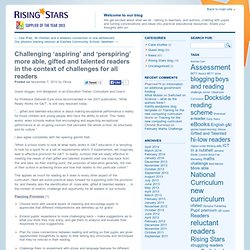
Teacher Quality, Wiggins and Hattie: More Doing the Wrong Things the Right Ways. In a blog titled “To my critics” as a follow up to his critique of Diane Ravitch’s Reign of Errors, Grant Wiggins seeks to clarify his central arguments: My point was merely to ask those who speak only of forces outside of our immediate control as educators to attend to what is not only in our control but can make a big difference….Teachers and schools make a difference, a significant one.

And we are better off improving teaching, learning, and schooling than anything else as educators because that’s what is in our control. Am I denying or tolerating poverty? Guide to Developing Good Questions. This question development guide was one first developed in a previous school which I have updated recently.
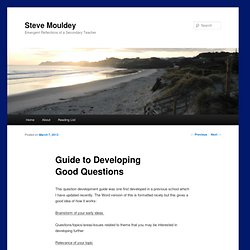
The Word version of this is formatted nicely but this gives a good idea of how it works: Brainstorm of your early ideas Questions/topics/areas/issues related to theme that you may be interested in developing further Relevance of your topic What big ideas and/or concepts will I learn about from doing this topic? 8 things educators need to know about the brain. 1).
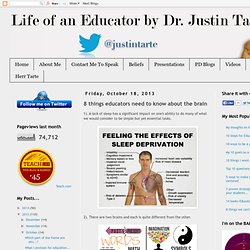
A lack of sleep has a significant impact on one's ability to do many of what we would consider to be simple but yet essential tasks. 2). There are two brains and each is quite different from the other. 3). The girl brain and the boy brain have some significant differences that affect learning and affect brain development. Angela Lee Duckworth: The key to success? Grit. The Dangers of Over-Celebrating Our Children. Many argue today that our overzealous embrace of the positive self-esteem movement has created a generation of attention junkies addicted to excessive and unearned positive feedback.

As a teacher I see some of this, but I am also struck by additional concerns. Certainly, many adults are engaged in the "empty praise" game, handing out words like "amazing! " when a child has hardly engaged with the work. And we give away too many meaningless prizes in the name of equity. Even more troubling: many adults are offering inflated praise for work that they have had a personal hand in making a little more complete, a little more clever, a little more impressive. Brains, Brains, Brains! How the Mind of a Middle Schooler Works.
In honor of October's most awesome of holidays, I am going to begin a three-part series about the gentlemen zombie's choice of cuisine: the 'tween brain.
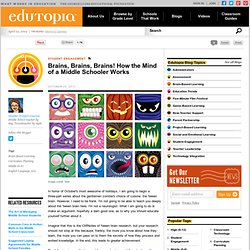
However, I need to be frank. I'm not going to be able to teach you deeply about the 'tween brain here. I'm not a neurologist. What I am going to do is make an argument, hopefully a darn good one, as to why you should educate yourself further about it. Report: American Education Isn't Mediocre—It's Deeply Unequal - Julia Ryan. Students in Massachusetts are doing great compared to their international peers, according to the National Center for Educational Statistics.
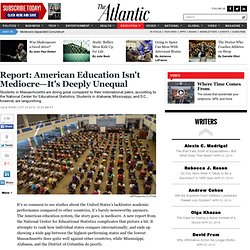
Students in Alabama, Mississippi, and D.C., however, are languishing. It’s so common to see studies about the United States’s lackluster academic performance compared to other countries, it’s barely newsworthy anymore. The American education system, the story goes, is mediocre. A new report from the National Center for Educational Statistics complicates that picture a bit.
It attempts to rank how individual states compare internationally, and ends up showing a wide gap between the highest-performing states and the lowest: Massachusetts does quite well against other countries, while Mississippi, Alabama, and the District of Columbia do poorly. Only some states took the TIMMS to create the U.S. score, so for the U.S. states that did not take the TIMSS in 2011, the report used NAEP scores to predict the what the state’s TIMSS scores would have been. Hattie Ranking: Influences And Effect Sizes Related To Student Achievement. John Hattie developed a way of synthesizing various influences in different meta-analyses according to their effect size (Cohen’s d). In his ground-breaking study “Visible Learning” he ranked 138 influences that are related to learning outcomes from very positive effects to very negative effects.
Hattie found that the average effect size of all the interventions he studied was 0.40. Therefore he decided to judge the success of influences relative to this ‘hinge point’, in order to find an answer to the question “What works best in education?” Originally, Hattie studied six areas that contribute to learning: the student, the home, the school, the curricula, the teacher, and teaching and learning approaches.
(The updated list also includes the classroom.) Education Week. Today's guest post is written by Eric Jensen, the author of just-released Engaging Students with Poverty in Mind (ASCD).
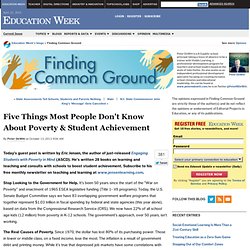
He's written 28 books on learning and teaching and consults with schools to boost student achievement. Subscribe to his free monthly newsletter on teaching and learning at www.jensenlearning.com. Stop Looking to the Government for Help. Resources and Downloads for Differentiated Instruction. Tips for downloading: PDF files can be viewed on a wide variety of platforms -- both as a browser plug-in or a stand-alone application -- with Adobe's free Acrobat Reader program.

Click here to download the latest version of Adobe Reader. Click on any title link below to view or download that file. Teaching Personal/Social Management Skills in Physical Education. In physical education, curricular requirements such as fitness development, motor skills and health knowledge must be pursued with vigor. But after my 38 years in the field, let me state the obvious. All teachers, specialists included, should consider their subject matter as secondary to teaching children.
This primary mission occurs when we prioritize two goals: Building a sound relationship between teacher and studentGuiding the student in the study of personal/social management skills (PSMS) When students acquire PSMS, they are more likely to succeed academically, in play and in work. Internet Catalogue. Engaged Teaching: "Do Now" Activities for Your Lessons. This is a follow up to a May 2013 blog about The Five Dimensions of Engaged Teaching (Solution Tree, 2013), by Laura Weaver and Mark Wilding -- a book that offers SEL and Common Core-compatible approaches to instruction.
As co-executive directors of the Passageworks Institute in Boulder, Colorado, Laura and Mark share with us practical examples of how educators of all grade levels might "Do Now" in classrooms some of their suggestions. Elementary School. Sum it Up, Get the Gist. Six Scaffolding Strategies to Use with Your Students. What’s the opposite of scaffolding a lesson? Saying to students, “Read this nine-page science article, write a detailed essay on the topic it explores, and turn it in by Wednesday.”
Yikes! No safety net, no parachute—they’re just left to their own devices. Cooperative. Some Cooperative Learning Projects by Cybrary Man Country or State Project Materials: Construction paper sheets of all the colors in each flag of the country or state. Scissors, glue, tape or stapler, rulers and markers. Large blank construction paper for map. Research: How SEL Classroom Management Techniques Build Academic Achievement. Respect, responsibility, and a community-based learning atmosphere promote success at Mount Desert Elementary School, a K-8 public school in Northeast Harbor, Maine. Education Week. Daily Assessment Of Students With Tiered Exit Cards. Introduction: Understanding the Mastery Principle. By Robyn R. Responding to Student Comments and Using Praise Appropriately. CIIA: Teaching and Learning Resources - Teaching Tips - Assessment and Grading. Introduction. Edunators - Helping Teachers Overcome Obstacles and Focus on Learning - The Two Things Teachers Focus on Most....Instead of Learning.
Details. A Primer For Mixing Introverts & Extroverts In The Classroom. A Primer For Mixing Introverts & Extroverts In The Classroom. How To Choose Collaborative Group Members. Edunators - Helping Teachers Overcome Obstacles and Focus on Learning - The Two Things Teachers Focus on Most....Instead of Learning. Susan Cain: The power of introverts. Differentiating Instruction for Children With Learning Disabilities.
There are a number of instructional interventions that will help children with learning disabilities learn social studies content and master social studies processes (Lewis & Doorlag, 2006; Sheehan & Sibit, 2005; Steele, 2005; Tomlinson, 2001; 2003; Turnbull, Turnbull, & Wehmeyer, 2007). Children with learning disabilities have difficulty in basic psychological processes as evidenced by problems with listening, thinking, speaking, reading, writing, spelling, and mathematical calculations.
Common Core for ELLs: Resource Roundup. With the beginning of the new school year, this week I’ll share some recently developed Common Core materials for English language learners that have been updated or that I have recently become aware of. How one great teacher was wronged by flawed evaluation system. Setting Objectives and Providing Feedback. Seven Tips for Better Classroom Management. How To Make Lesson Objectives Clear To Students. Guaranteeing Challenging, Engaging, and Intentional Instruction.
Instructional Practice. Watch a Classroom Management Expert. The Power of Belief - Mindset and Success: Eduardo Briceno at TEDxManhattanBeach. Bloom's Taxonomy According To Jerry Seinfeld. Classroom Management Strategy: Setting The Tone. 10 talks from inspiring teachers. Five-Minute Film Festival: Digging Into the Common Core. Change Your Brain, Change Your Life - In Photos: How To Change Your Brain For The Better. Differentiating Groups on eduClipper. Struggle For Smarts? How Eastern And Western Cultures Tackle Learning : Shots - Health News.
How to Get Students Ready for Learning. An ASCD Study Guide for The 12 Touchstones of Good Teaching: A Checklist for Staying Focused Every Day. Instructional Videos About Teaching and Teachers. Annenberg Learner List of Workshops and Courses. Inclusive "Best Practices" Videos / Overview. “Best Practices” Project – BLaST Intermediate Unit 17. Inspirational Teaching Videos: Covering Common Core, Math, Science, English And More. Staff Development Videos. Inclusive "Best Practices" Videos / Overview. Instructional Videos About Teaching and Teachers. Education Video Library. Use Selective Highlighting To Teach Students To Read With A Purpose.
The Art Of Questioning For Teachers: Improve Your Teaching Techniques. Tips To Have Students Ask Better Questions. Common Core: Teaching Argument & Informational Paragraph Writing. The 7 Most (And Least) Effective Ways To Improve Student Achievement. Teaching Students To Think And Analyze. Videos, Common Core Resources And Lesson Plans For Teachers: Teaching Channel. Tips To Have Students Ask Better Questions. Text Complexity: Simplifying Text Complexity And The Common Core.
Teaching Higher Order Thinking Skills In Middle School. Education Week. CompleteToolkit. The Power of Belief - Mindset and Success: Eduardo Briceno at TEDxManhattanBeach. The Five Attitudes and Beliefs of Expert Teachers (from John Hattie’s book Visible Learning for Teachers) Rethinking Whole Class Discussion. Bill of Rights Institute: Prohibition Resources Download. Twitter. Teach Informational Texts Alongside The Literature You Love. Twitter.
The Future of Tablets in Education: Potential Vs. Reality of Consuming Media. The Five Attitudes and Beliefs of Expert Teachers (from John Hattie’s book Visible Learning for Teachers) 16 Of The Best Opening Lines From Children's Books. The Five Attitudes and Beliefs of Expert Teachers (from John Hattie’s book Visible Learning for Teachers) Periodic-Table.png 720×540 pixels. The Long-Term Impact Of Great Teachers. Rethinking Whole Class Discussion. 1st Annual MTSS Conference Evaluation. Change Magazine - September-October 2010. Connecting.png 800×2,940 pixels. Change Magazine - September-October 2010. Free Classroom Guides and Educational Downloads. Brain-Based Learning: Resource Roundup. The Heart-Brain Connection: The Neuroscience of Social, Emotional, and Academic Learning.